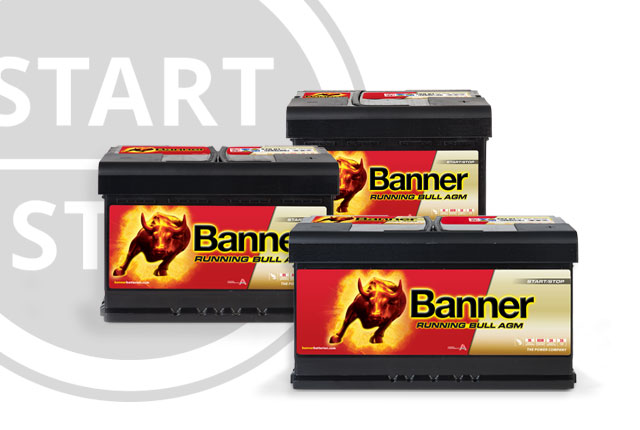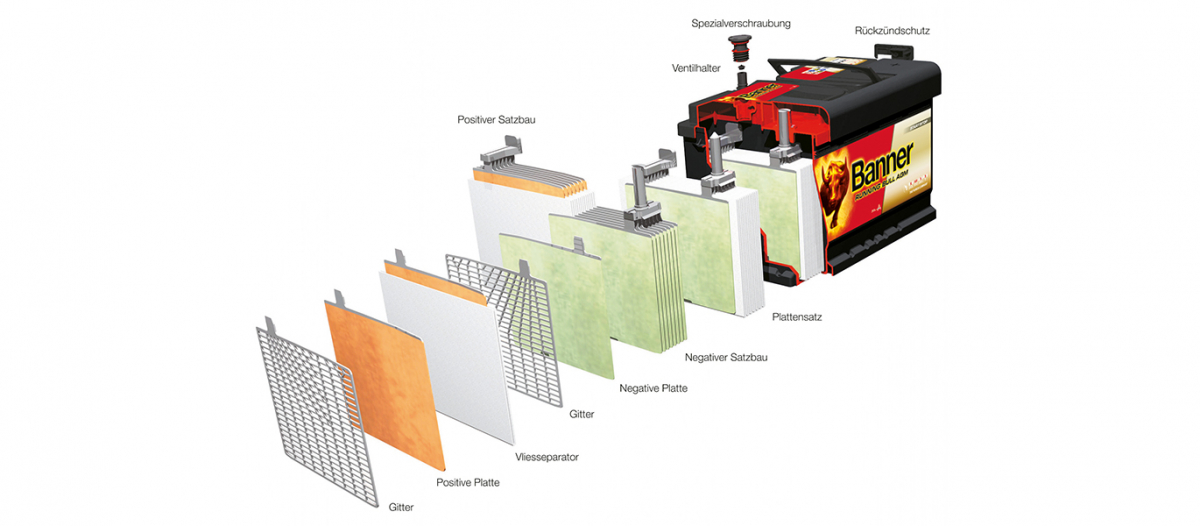WHAT IS AN AGM BATTERY?
BATTERY FOR START-STOP VEHICLES
Basically, two different battery technologies are used for vehicles with automatic start-stop systems,
depending on the energy requirements and necessary vibration or cycle stability.
- AGM (Absorbent Glass Mat): the acid is absorbed into the glass fleece and thus bound.
- EFB (Enhanced Flooded Battery): the cycle-stable starter battery with liquid electrolyte

AGM battery
- AGM - Absorbent Glass Mat: the acid is absorbed in the glass mat and cannot leak
- = VRLA - Valve Regulated Lead Acid: a valve-regulated lead-acid battery with AGM technology
- Running Bull AGM: starter and on-board battery for start-stop vehicles with the highest energy requirements and braking energy recuperation, also increasingly used as an on-board battery in electric cars
- for middle and upper class vehicles up to luxury class
- up to 360,000 engine starts
- Running Bull BackUp: back-up battery for start-stop vehicles or electric cars with the highest energy requirements and braking energy recuperation
AGM technology (Running Bull AGM, Running Bull BackUp) is primarily used in start-stop systems with the highest energy requirements, braking energy recuperation and for optimum on-board power supply stability. The Running Bull AGM battery is the optimal solution here, primarily for medium and luxury class vehicles. AGM (Absorbent Glass Mat) is a recombination battery. AGM batteries are also used in the commercial vehicle sector, especially in the long-distance HGV sector with the Buffalo Bull AGM battery variant, for high energy requirements due to increasing comfort functions and extreme vibration resistance with integral rear installation of the battery.
A glass mat separator absorbs the acid and leaves enough pores free to allow oxygen diffusion from the positive to the negative plate. At the negative plate the oxygen combines with lead to form lead oxide. This lead oxide then reacts with the sulphuric acid to form lead sulphate, whereby water is produced as a reaction product. The charge converts the lead sulphate back to metallic lead. The result is no loss of water.
However, if too much gas is produced due to charging voltages that are too high or extremely hot temperatures, not all of the gases formed can recombine fully. The pressure in the battery increases continuously until the safety valves are opened.
Differences compared to a conventional wet battery or EFB battery
- Battery case with reinforced sidewalls – to absorb the pressure of the set installation and recombination.
- Special screw connections – with overpressure valve to prevent the battery from bursting in the event of overcharging, for example.
- Special AGM separators: manufactured with utmost accuracy and glass mat support because optimal compression and saturation of the separator are two of the basic prerequisites for the perfect functioning of the AGM battery.
- Higher lead content: this is necessary because there is no “acid reserve” as is the case with a wet battery.
- AGM batteries manage up to approx. 360,000 engine starts, in direct comparison up to approx. 270,000 starts for EFB batteries and up to approx. 120,000 starts for conventional wet batteries.
Unbeatable user benefits
Triple cycle strength compared to conventional starter batteries and highest vibration resistance in continuous operation. Leak-proof thanks to the fact that the electrolyte is bound in a glass mat (Absorbent Glass Mat). Up to 360,000 engine starts
If energy recovery is also carried out in the vehicle (recovery of braking energy), the AGM battery works artificially at a lower state of charge (SOC State Of Charge of approx. 70%). Depending on the driving profile (short distance, stop-and-go, etc.), a conventional wet battery will be defective within a few months in this application due to the extremely high cyclic load.
PS: The AGM battery is also used in the commercial vehicle sector, especially in the long-distance truck sector the Buffalo Bull AGM battery variant, with the highest energy demand due to increasing comfort functions and extreme vibration resistance with integral rear installation of the battery.

Changing an AGM battery
If a motor vehicle is equipped with an AGM battery as standard, it is essential to replace it with an AGM battery. In an identical housing and of a similar performance class.
PS: Minor deviations in capacity or performance during a cold start have no effect on the safe start and the optimum power supply of the electrical system.
Please note!
Never install a conventional wet-cell battery in a passenger vehicle with a start-stop function that is equipped with an Absorbent Glass Mat or AGM or EFB battery as standard.
AGM know-how in a nutshell
1. Always replace AGM batteries with AGM batteries! Never downgrade to EFB or conventional wet batteries.
2. Do not open the screw connections! It is not possible or necessary to measure the acid density or top up with distilled water.
3. BEM compatible (battery energy management)
4. EBS/IBS compatible (electronic battery sensor/intelligent battery sensor)
AGM batteries are very often used in cars with automatic start-stop systems and brake energy recovery (recuperation). Both technologies place the highest demands on starter and on-board batteries, which conventional wet batteries can no longer fulfil. Even luxury cars with a large number of additional electrical consumers benefit from the extremely high cycle stability of AGM batteries. They are also ideal for off-road use thanks to their extremely high resistance to vibration and leakage, the latter of which enables extreme sloping positions in off-road use.
Good to know! More and more electric cars are being fitted with 12V vehicle electrical system batteries with AGM technology, or an upgrade can be made in terms of battery technology.
Banner tip! Not to be forgotten is the use in the hobby and leisure sector/camping caravan: It is best to use a starter and on-board power supply battery such as Running Bull AGM to start the engine, especially in caravans and motorhomes - not only for winter camping.
More articles on this topic

